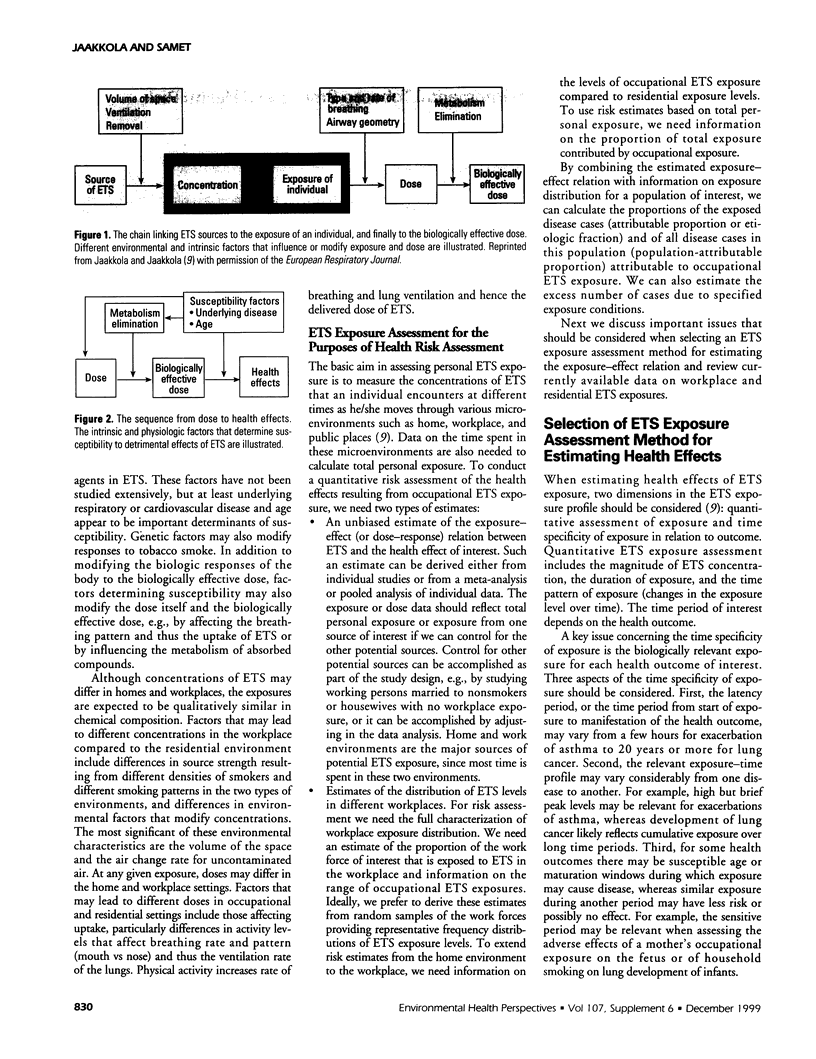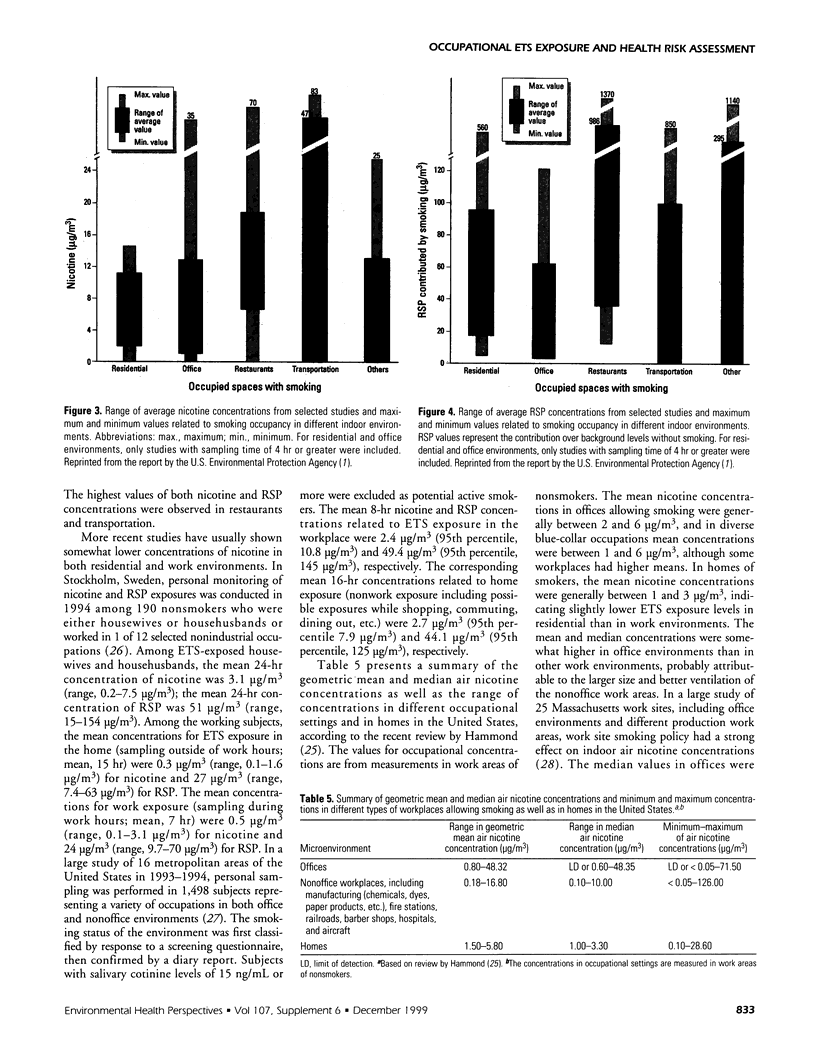Abstract
This article addresses concepts of environmental tobacco smoke (ETS) exposure assessment relevant for health risk assessment based on human studies. We present issues that should be considered when selecting a method for ETS exposure assessment for the purposes of health risk assessment and review data on ETS exposure levels in the workplace and in home environments. Two types of estimates are needed for a quantitative risk assessment of the health effects resulting from occupational ETS exposure: (italic)a(/italic)) an unbiased estimate of the exposure-effect (or dose-response) relation between ETS and the health effect of interest, and (italic)b(/italic)) estimates of the distribution of ETS exposure in different workplaces. By combining the estimated exposure-effect relation with information on exposure distribution for a population of interest, we can calculate the proportions of disease cases attributable to occupational ETS exposure as well as the excess number of cases due to specified exposure conditions. Several dimensions of the exposure profile should be considered when assessing ETS exposure for estimating the exposure-effect relation, including the magnitude of exposure and the biologically relevant time specificity of exposure. The magnitude of exposure is determined by the ETS source strength, environmental factors modifying concentrations, and duration of exposure. Time specificity considerations include the latency period for each health outcome of interest, the time-exposure profile relevant for different disease mechanisms, and the sensitive age period with regard to health effects. The most appropriate indicator of ETS exposure depends on these factors and on the time period that can be assessed with different methods.
Full text
PDF






Images in this article
Selected References
These references are in PubMed. This may not be the complete list of references from this article.
- Benowitz N. L. Cotinine as a biomarker of environmental tobacco smoke exposure. Epidemiol Rev. 1996;18(2):188–204. doi: 10.1093/oxfordjournals.epirev.a017925. [DOI] [PubMed] [Google Scholar]
- Coultas D. B., Samet J. M., McCarthy J. F., Spengler J. D. Variability of measures of exposure to environmental tobacco smoke in the home. Am Rev Respir Dis. 1990 Sep;142(3):602–606. doi: 10.1164/ajrccm/142.3.602. [DOI] [PubMed] [Google Scholar]
- Crawford F. G., Mayer J., Santella R. M., Cooper T. B., Ottman R., Tsai W. Y., Simon-Cereijido G., Wang M., Tang D., Perera F. P. Biomarkers of environmental tobacco smoke in preschool children and their mothers. J Natl Cancer Inst. 1994 Sep 21;86(18):1398–1402. doi: 10.1093/jnci/86.18.1398. [DOI] [PubMed] [Google Scholar]
- Glantz S. A., Parmley W. W. Passive smoking and heart disease. Epidemiology, physiology, and biochemistry. Circulation. 1991 Jan;83(1):1–12. doi: 10.1161/01.cir.83.1.1. [DOI] [PubMed] [Google Scholar]
- Hammond S. K., Coghlin J., Gann P. H., Paul M., Taghizadeh K., Skipper P. L., Tannenbaum S. R. Relationship between environmental tobacco smoke exposure and carcinogen-hemoglobin adduct levels in nonsmokers. J Natl Cancer Inst. 1993 Mar 17;85(6):474–478. doi: 10.1093/jnci/85.6.474. [DOI] [PubMed] [Google Scholar]
- Hammond S. K. Exposure of U.S. workers to environmental tobacco smoke. Environ Health Perspect. 1999 May;107 (Suppl 2):329–340. doi: 10.1289/ehp.99107s2329. [DOI] [PMC free article] [PubMed] [Google Scholar]
- Hammond S. K., Sorensen G., Youngstrom R., Ockene J. K. Occupational exposure to environmental tobacco smoke. JAMA. 1995 Sep 27;274(12):956–960. [PubMed] [Google Scholar]
- Hecht S. S., Carmella S. G., Murphy S. E., Akerkar S., Brunnemann K. D., Hoffmann D. A tobacco-specific lung carcinogen in the urine of men exposed to cigarette smoke. N Engl J Med. 1993 Nov 18;329(21):1543–1546. doi: 10.1056/NEJM199311183292105. [DOI] [PubMed] [Google Scholar]
- Hoffmann D., Hoffmann I. The changing cigarette, 1950-1995. J Toxicol Environ Health. 1997 Mar;50(4):307–364. doi: 10.1080/009841097160393. [DOI] [PubMed] [Google Scholar]
- Jaakkola M. S., Jaakkola J. J. Assessment of exposure to environmental tobacco smoke. Eur Respir J. 1997 Oct;10(10):2384–2397. doi: 10.1183/09031936.97.10102384. [DOI] [PubMed] [Google Scholar]
- Jaakkola M. S., Jaakkola J. J., Becklake M. R., Ernst P. Effect of passive smoking on the development of respiratory symptoms in young adults: an 8-year longitudinal study. J Clin Epidemiol. 1996 May;49(5):581–586. doi: 10.1016/0895-4356(96)00004-2. [DOI] [PubMed] [Google Scholar]
- Jenkins R. A., Palausky A., Counts R. W., Bayne C. K., Dindal A. B., Guerin M. R. Exposure to environmental tobacco smoke in sixteen cities in the United States as determined by personal breathing zone air sampling. J Expo Anal Environ Epidemiol. 1996 Oct-Dec;6(4):473–502. [PubMed] [Google Scholar]
- Leaderer B. P., Lioy P. J., Spengler J. D. Assessing exposures to inhaled complex mixtures. Environ Health Perspect. 1993 Dec;101 (Suppl 4):167–177. doi: 10.1289/ehp.93101s4167. [DOI] [PMC free article] [PubMed] [Google Scholar]
- Maclure M., Katz R. B., Bryant M. S., Skipper P. L., Tannenbaum S. R. Elevated blood levels of carcinogens in passive smokers. Am J Public Health. 1989 Oct;79(10):1381–1384. doi: 10.2105/ajph.79.10.1381. [DOI] [PMC free article] [PubMed] [Google Scholar]
- Nilsen T., Zahlsen K., Nilsen O. G. Uptake of nicotine in hair during controlled environmental air exposure to nicotine vapour: evidence for a major contribution of environmental nicotine to the overall nicotine found in hair from smokers and non-smokers. Pharmacol Toxicol. 1994 Sep-Oct;75(3-4):136–142. doi: 10.1111/j.1600-0773.1994.tb00336.x. [DOI] [PubMed] [Google Scholar]
- Ott W. R. Human exposure assessment: the birth of a new science. J Expo Anal Environ Epidemiol. 1995 Oct-Dec;5(4):449–472. [PubMed] [Google Scholar]
- Ott W. R. Mathematical models for predicting indoor air quality from smoking activity. Environ Health Perspect. 1999 May;107 (Suppl 2):375–381. doi: 10.1289/ehp.99107s2375. [DOI] [PMC free article] [PubMed] [Google Scholar]
- Phillips K., Bentley M. C., Howard D. A., Alván G. Assessment of air quality in Stockholm by personal monitoring of nonsmokers for respirable suspended particles and environmental tobacco smoke. Scand J Work Environ Health. 1996;22 (Suppl 1):1–24. [PubMed] [Google Scholar]
- Repace J. L., Jinot J., Bayard S., Emmons K., Hammond S. K. Air nicotine and saliva cotinine as indicators of workplace passive smoking exposure and risk. Risk Anal. 1998 Feb;18(1):71–83. doi: 10.1111/j.1539-6924.1998.tb00917.x. [DOI] [PubMed] [Google Scholar]
- Trédaniel J., Boffetta P., Saracci R., Hirsch A. Exposure to environmental tobacco smoke and adult non-neoplastic respiratory diseases. Eur Respir J. 1994 Jan;7(1):173–185. doi: 10.1183/09031936.94.07010173. [DOI] [PubMed] [Google Scholar]
- Trédaniel J., Boffetta P., Saracci R., Hirsch A. Exposure to environmental tobacco smoke and risk of lung cancer: the epidemiological evidence. Eur Respir J. 1994 Oct;7(10):1877–1888. doi: 10.1183/09031936.94.07101877. [DOI] [PubMed] [Google Scholar]





